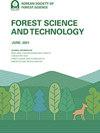Short-term effects of tree thinning on microhabitat variables and rodents in Japanese larch Larix kaempferi forest
IF 2.2
Q2 FORESTRY
引用次数: 4
Abstract
Abstract We examined the short-term effects of tree thinning on microhabitat factors and the abundances of striped field mice Apodemus agrarius, Korean field mice Apodemus peninsulae, and Korean red-backed voles Myodes regulus within a Japanese larch Larix kaempferi forest in South Korea. Three different stands were thinned to 0%, 25%, or 50%. Ground vegetation was higher in the second year of tree thinning than in the first year. In the first year of thinning, ground vegetation was significantly higher in the control than in the 50% thinned stand, whereas the opposite trend was observed in the second year. Mid-story vegetation was higher in the control than in the 50% thinned stand. In the first year of thinning, the sub-overstory vegetation was higher in the control than in the 50% thinned stand. Basal area was the highest in the control stand. Abundances of the three rodent species were higher in the second year of tree thinning than in the first year. The abundance of A. peninsulae was higher in the control than in the 50% thinned stand. Overall, the three rodent species preferred microhabitats with dense ground vegetation. Our results showed that the short-term effects of tree thinning altered microhabitat factors and disturbed microhabitat conditions in the first year; furthermore, the 50% thinned stand did not provide suitable habitats for A. peninsulae. In this study, moderate (25%) tree thinning resulted in a convenient balance between biodiversity conservation and human demands for forest wood.疏林对日本落叶松森林微生境变量和啮齿动物的短期影响
摘要研究了日本落叶松日本落叶松森林内树木间伐对黑线田鼠、朝鲜田鼠和朝鲜红背田鼠微生境因子及丰度的短期影响。三种不同的林分分别减薄至0%、25%和50%。地面植被在疏林第二年高于第一年。间伐第一年,对照林的地面植被显著高于50%间伐林,第二年则相反。间伐50%林分的中层植被高于对照林。间伐第一年,对照林分亚层植被高于50%间伐林分;对照林分基部面积最高。3种啮齿动物的丰度在疏林第二年均高于第一年。半岛白桦的丰度在对照林中高于50%间伐林下。总体而言,三种啮齿动物偏好地面植被密集的微生境。结果表明:森林间伐的短期效应在第一年改变了微生境因子,干扰了微生境条件;此外,50%的林分不适合半岛白杨生长。在本研究中,适度(25%)的树木间伐在生物多样性保护和人类对森林木材的需求之间取得了方便的平衡。
本文章由计算机程序翻译,如有差异,请以英文原文为准。
求助全文
约1分钟内获得全文
求助全文

 求助内容:
求助内容: 应助结果提醒方式:
应助结果提醒方式:


